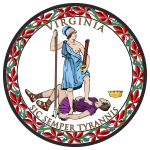Virginia Senate

The Senate of Virginia is the upper house of the Virginia General Assembly. The Senate is composed of 40 senators representing an equal number of single-member constituent districts. The Senate is presided over by the lieutenant governor of Virginia. Prior to the American War of Independence, the upper house of the General Assembly was represented by the Virginia Governor's Council, consisting of up to 12 executive counselors appointed by the colonial royal governor as advisers and jurists. The lieutenant governor presides daily over the Virginia Senate. In the lieutenant governor's absence, the president pro tempore presides, usually a powerful member of the majority party. The Senate is equal with the House of Delegates, the lower chamber of the legislature, except that taxation bills must originate in the House, similar to the federal U.S. Congress. The 40 senatorial districts in Virginia elect their representatives every four years on the Tuesday following the first Monday in November. The last election took place in November 2019. There are no term limits for senators. The Senate also employs 36 pages (ages 13–14) to help with daily tasks during each general session in a full-time residential program of high regard.
Excerpt from the Wikipedia article Virginia Senate (License: CC BY-SA 3.0, Authors, Images).Virginia Senate
Bank Street, Richmond Shockoe Slip
Geographical coordinates (GPS) Address Phone number Website Nearby Places Show on map
Geographical coordinates (GPS)
| Latitude | Longitude |
|---|---|
| N 37.538972222222 ° | E -77.433805555556 ° |
Address
Virginia State Capitol
Bank Street 1000
23219 Richmond, Shockoe Slip
Virginia, United States
Open on Google Maps










